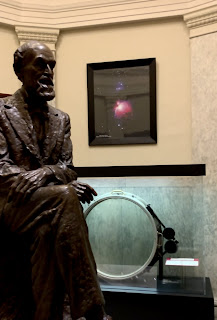It's the seventh day of Christmas. Do you know where your swans are swimming?
I look forward to reading the Christmas Price Index every year. That's the list detailing how much the traditional twelve days worth of holiday gifts would cost in today's economy. It was instituted in 1984 by Pittsburgh's own PNC Bank, gets updated annually, and receives attention whenever the media needs some holiday filler.
Turmoil on the world stage has apparently eclipsed communal concerns about the cost of a partridge in a pear tree, because I've not seen much made of the rising costs of festive fowl and revelry. At this writing, if you're looking to gift your true love carol-style, the grand total will be over $150,0000 for all 364 gifts. Not sure of the tax ramifications of those purchases for the 1% who can afford them.
There's always been abuse heaped upon the Twelve Days of Christmas song, a leading contender for stupidest holiday carol ever. At our house the winners include anything by the Jingle Dogs, that Santa Baby song, and Frosty the Snowman. Particularly Frosty. My bias is always against any character who sounds like he needs to blow his nose. (Pooh Bear, I'm looking at you).
I'll grant that Twelve Days begs to be parodied. Mock-worthy as it is, there are countless versions with lyrics of varying degrees of cleverness.
But I'm going on record to declare that it's a childhood favorite of mine.
Back in the days before the Internet made verifying lyrics effortless, I was proud of my ability to memorize and recite the Twelve Days lyrics through sheer dogged repetition. I can't say that my family was enamored of all that hard work, because it mostly occurred in the backseat of the car when we were driving somewhere. I was pleased with myself despite their lack of enthusiasm and I still like the carol. I also appreciate the historical continuity it represents.
Twelve days constitute the Christmas season in Western and Eastern Christian church traditions, and the aptly-named Twelfth Night falls on Epiphany. Take your pick as far as to what date that might be, though. The Western church begins the count on Christmas Day so that Epiphany falls on January 5th, while in the Eastern tradition the "first day of Christmas" is December 26th and Epiphany falls on January 6th. Whenever it is celebrated, Epiphany marks the visit of the Magi, who arrived to present gifts to the young Jesus. Bible stories never do specify how many wise visitors there were and some Eastern traditions even say that there were twelve. I like the idea of an even dozen bearing twelve gifts for a mystical total of 364 gifts, one for each day of the year except, uhm, I guess Christmas?
 |
| Journey of the Magi, Benozzo Gozzoli, 1459-62, with my Medici faves parading |
Much religious significance has been attached to the carol, and there's a vague general notion that it originated in 16th century England. That was the time of the Protestant Reformation, a period of religious revolution that Henry VIII sort of unintentionally provoked by declaring himself head of the Church in England so he could grant himself the divorce that the Pope had denied for, well, complicated political reasons.
There's this idea that the Twelve Days of Christmas carol was mnemonically constructed to help educate the Roman Catholic faithful in the doctrines of their faith during the Reformation. Supposedly the carol allowed them to teach their children important things while remaining under the radar of would-be persecutors, because the song's repetitive nature assured that they'd not have to write anything incriminating. Adherents to this origin story believe that the carol's 'true love' is God, the 'partridge in a pear tree' is Christ on the cross, and the 'three French hens' represent the Trinity.
Or maybe the three theological virtues of Faith Hope and Charity.
Or the three gifts of the Magi.
No one really knows for sure. But the supposed allegorical references continue: two Biblical Testaments are represented, four Gospels, five books of the Torah, seven Sacraments, eight Beatitudes, nine hierarchies of angels, ten Commandments, eleven faithful apostles, and twelve articles of the Apostles' Creed. Or maybe that's the twelve tribes of Israel?
Unfortunately for those who like their holiday carols fraught with religious symbolism, there's not a shred of documentation to back up this origin story. The theory seems to have had its virgin birth in the 1970s, gaining widespread acceptance through a 1992 Our Sunday Visitor Catholic newspaper article.
Aside from the lack of evidence to support this allegorical theory, simple logic speaks against it. The catechetical associations that the carol purportedly spells out were actually NOT unique to the Roman Church as compared to beliefs of Henry's newly-formed English-centric church at the point in time in question. EVERYONE back then KNEW this stuff. Passing along this info didn't merit the creation of a cumulative carol of dubious musicianship. Folkloric explanations are captivating, though, so these lyrical religious attributions still get passed on as if they were Gospel truths themselves.
The real history of the song is intriguing enough without added associations. The twelve days of the Christmastide season were filled with joyous feasts and frolics. It all climaxed on Twelfth Night, which for most of Christian holiday history was a more festive occasion than Christmas itself. Birthday celebrations are more recent cultural customs, even Divine birthdays, and Christmas itself wasn't made much of until Victorian times. Up until the 19th century, it really was Epiphany that represented the revelation of Jesus.
The exact origins of the Twelve Days of Christmas carol are lost to time and memory, but most likely it began as musical accompaniment to a medieval “memories and
forfeits game” that was enjoyed during Christmastide. A leader recited verses that followers had to repeat exactly, or else forfeit a sweet or kiss or pay some other playful penalty. The carol was presented this way in its first known publication, a 1780 children's book called Mirth Without Mischief.
Musicologists have suggested that the carol has French origins, given some of the items mentioned in the song. For example, the kinds of partridges which roost in trees were introduced from France to England in the late 1770s, and the song definitely predates their introduction. There are even theories that the "in a pear tree" lyric is a mondegreen; the line should be "and a partridge, un perdis" (perdis being French for partridge).
Different customs have evolved over time and place for the Christmas season. Some people give gifts only on Christmas Day, some solely on Twelfth Night, and some lucky souls receive gifts on all of the twelve nights. Here in the United States, we've largely lost any traditions associated with the Twelve Days of Christmas, although if you live at my house you'll continue to get a gift in your stocking on each day, and Epiphany is our holiday de-decorating date. Of course if you live in an area that celebrates Carnival, like New Orleans, you're just getting started on Twelfth Night, so it's not so much an ending but a beginning to revelry.
This song is part of the fun. It's really no more than what it appears to be: a fun secular carol about music, dancing, and getting stuff - albeit weird stuff, like calling birds. Ohhhhhh yeah, those "calling" birds? That's messed up, too. It was a point of pride for me as a wee pedantic Sue to get the lyrics right, so I am here to tell you that the lyric is not "calling birds" but "colly" birds. Once upon a time, "colly" was another word for black. That lyric would have been understood as referring to four blackbirds. We can
blame English composer Frederic Austin for publishing the arrangement in 1909 that we sing today, codifying the substitution of "calling birds" for "colly birds."
I will console myself over this change by thinking of my doggo here as a colly collie.
The Twelve Days of Christmas song has captured the popular imagination, for good or ill, in all its variations and parodies. Several countries, including the United States have even issued postage stamps to represent the gifts sung about in the carol, which you can see on THIS SITE.
But it's really all much ado about birds, maids, lords, feasting and revelry. Just like any good party should be.
Whatever holiday you celebrate and whatever meaning you attach to your symbols, I wish you great joy of it, and a happy new year, too.






















